Lekeberg Municipality facts for kids
Quick facts for kids
Lekeberg Municipality
Lekebergs kommun
|
||
|---|---|---|
 |
||
|
||
 |
||
| Country | Sweden | |
| County | Örebro County | |
| Seat | Fjugesta | |
| Area | ||
| • Total | 484.18 km2 (186.94 sq mi) | |
| • Land | 465.96 km2 (179.91 sq mi) | |
| • Water | 18.22 km2 (7.03 sq mi) | |
| Area as of January 1, 2010. | ||
| Population
(June 30, 2012)
|
||
| • Total | 7,122 | |
| • Density | 14.7094/km2 (38.0972/sq mi) | |
| Time zone | UTC+1 (CET) | |
| • Summer (DST) | UTC+2 (CEST) | |
| ISO 3166 code | SE | |
| Province | Närke | |
| Municipal code | 1814 | |
| Website | www.lekeberg.se | |
Lekeberg Municipality (Lekebergs kommun) is a cool area in central Sweden. It's like a local government area in Örebro County. The main town, or "seat," is Fjugesta, which has about 2,000 people living there.
Lekeberg Municipality was first created in 1952 when five smaller areas joined together. In 1967, two more parishes (smaller church areas) were added. For a short time in 1971, it became part of Örebro Municipality. But in 1995, Lekeberg Municipality was re-established, going back to its 1967 borders.
Contents
Exploring Lekeberg's Nature and Work
Lekeberg is a beautiful place with lots of forests and farms. You can find Garphyttan National Park here, which was created way back in 1909 to protect nature.
The biggest job sector in Lekeberg is farming. Many farmers here specialize in raising pigs and chickens. Besides farming, there are also small businesses that work with wood and carpentry. You can also find people doing craftswork and other small businesses.
Main Towns and Villages
Here are some of the larger towns and villages in Lekeberg Municipality, each with over 200 people:
- Fjugesta (This is the main town!)
- Gropen
- Hidinge
- Lanna
- Mullhyttan
People and Population
Lekeberg Municipality is home to 8,596 residents. This includes 6,359 Swedish citizens who are old enough to vote. In the 2022 Swedish general election, about 41.8% of people voted for parties on the left side of politics, and 56.6% voted for parties on the right side.
Most people in Lekeberg are employed, meaning they have jobs and pay taxes. A large number of residents were born in Sweden with Swedish parents. The average income for adults is around 26,000 Swedish kronor per month. Many adults also have a college degree.
Voting in Lekeberg
People in Lekeberg Municipality have been voting in the Riksdag (Sweden's parliament) elections since 1994. The Riksdag is where laws are made for the whole country.
Here's a look at how people in Lekeberg have voted over the years:
| Year | Turnout | S | M | SD | Other Parties |
|---|---|---|---|---|---|
| 1994 | 87.2% | 39.3% | 16.8% | 0.0% | 43.9% |
| 1998 | 80.3% | 32.7% | 16.7% | 0.0% | 50.6% |
| 2002 | 81.8% | 36.5% | 11.2% | 2.4% | 49.9% |
| 2006 | 83.6% | 34.8% | 18.9% | 4.7% | 41.6% |
| 2010 | 86.4% | 30.7% | 24.8% | 7.5% | 37.0% |
| 2014 | 88.4% | 30.0% | 16.9% | 18.2% | 34.9% |
Note: "Turnout" means how many eligible people actually voted. "Other Parties" includes votes for parties like the Left Party, Green Party, Centre Party, Liberals, and Christian Democrats.
Historical Places to Visit
Lekeberg has some interesting historical sites:
Riseberga Monastery Ruins
The monastery ruin of Riseberga was once home to nuns from the Cistercian religious order during the medieval times. Sadly, it burned down in 1546. Later, some of the stones from the ruins were used to build a local church.
Riseberga Amphitheatre
Close by, you'll find the amphitheatre of Riseberga. This is Sweden's largest amphitheatre of its kind, with enough seats for 1,216 people! Imagine all the performances that could happen there.
Sister Cities
Lekeberg has a "twin town" or "sister city" relationship with another town. This means they share a special connection and often visit each other.
- (1996) Dundaga, Latvia

Images for kids
See also
 In Spanish: Municipio de Lekeberg para niños
In Spanish: Municipio de Lekeberg para niños




